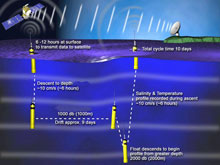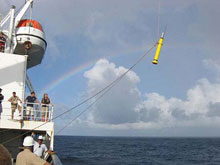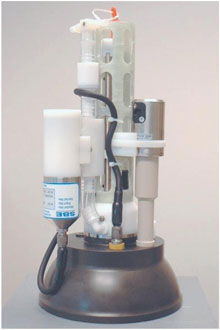Argo Floats
Argo is an international ocean-observing program with the goal of deploying 3,000 drifting floats that gather temperature and salinity profiles in the upper 2,000 meters of the world’s oceans. In conjunction with satellite observations, the profiles gathered by these floats have allowed scientists to make significant advances in their quest to better understand the role of the oceans in world climate. Forty-five governments worldwide participate in the program. Several components of NOAA have been instrumental in the U.S. Argo contribution.
- Introduction
- The Argo Program
- NOAA’s Role
- The Argo Float
- Making Argo Data Available
- Promising Opportunities
- Summary
- Works Consulted
Changes in the ocean and atmosphere affect all aspects of our lives, from deciding what crops to plant to where to spend a vacation. Understanding and predicting regional and global climate changes can provide enormous benefits to both the public and private sector. Today, an internatonal ocean-observing program known as "Argo" provides critical temperature and salinity data. However, until Argo began in 1999, the lack of both systematic worldwide observations of key factors that influence climate and the lack of accurate models that use observational data in climate forecasting made understanding and predicting these changes difficult.

Relying on commercial vessels to measure ocean temperature leaves large areas of the oceans unsampled (top). By contrast, the distribution of nearly 3,000 Argo floats (below) creates a more uniform and closely spaced worldwide sampling distribution of approximately every three degrees of latitude and longitude. Images courtesy of the Atlantic Oceanographic and Meteorological Lab, NOAA (top) and Argo Home Page (bottom).
Prior to Argo, knowledge about the interior of the ocean came primarily from measurements taken by research ships, moored buoys, and commercial vessels. But, the immensity of the ocean and the limited area where these vessels and platforms took measurements left large data-sparse areas such as the southern oceans. Observations outside tropical waters were often restricted to periods of favorable weather. And, data collected were often limited to water temperatures in the upper 750 meters of the ocean, with depth inferred from elapsed time and a fall-rate equation used in conjunction with instruments “free-falling” through the ocean. The Argo program initiated an era of global oceanographic monitoring with quality-controlled, real-time data availability to improve knowledge of the world’s oceans.
As with previous ocean subsurface data, Argo data are now assimilated into ocean forecast models. Today, thanks to the international cooperation that made Argo possible, scientists are closer than ever to being able to accurately predict changes in ocean temperature and salinity. These predictions may lead to better forecasting of worldwide and regional climate changes. Argo is a major contributor to the World Climate Research Program's Climate Variability and Predictability Experiment (CLIVAR) project and to the Global Ocean Data Assimilation Experiment (GODAE). The Argo array is part of the Global Climate Observing System/Global Ocean Observing System (GCOS/GOOS). A group of 45 nations, territories, unions, federations, and freely associated states worldwide participate in different aspects of Argo, from purchasing and fabrication to deployment and data management.
The Argo Program

One of roughly 3,000 Argo floats deployed in ice-free areas of the world’s oceans that profile ocean temperature and salinity. These floats dramatically reduce the amount of time and cost of gathering these data by research ships using traditional over-the-side methods of ocean observations.
The Argo program was conceived and designed by a group of U.S. academic and NOAA scientists to take data from the altimetry instruments aboard NASA’s Jason and TOPEX/Poseidon satellites that measure differences in ocean surface elevation and combine them with ocean temperature, salinity, and current profiles gathered by Argo floats. The program builds on the ocean sampling method developed during the World Ocean Circulation Experiment (WOCE) of the 1990s by creating a global array of 3,000 profiling floats spaced roughly in three-degree grids throughout ice-free ocean areas. The term ‘Argo’ comes from the name of the ship Argo in the tale of Jason and the Argonauts told in Greek mythology.
The Argo approach brings, for the first time, a uniform and systematic method for measuring the physical state of the upper ocean worldwide and for placing that information into climate computer models in near real-time. Previous ocean measurements, while numerous, were often confined to major shipping routes or areas where weather and season limited when observations could be taken. Argo floats significantly improve the coverage of ocean data sampling traditionally gathered by commercial and research vessels by providing more uniform coverage of the ocean both in time and space, by expanding the depth range and accuracy of measurements, and by adding salinity and current velocity information.
NOAA’s Role in the Argo Program
NOAA’s Atlantic Oceanographic and Meteorological Laboratory (AOML) and Pacific Marine Environmental Laboratory (PMEL) deploy or coordinate deployment of most U.S. Argo floats in the Atlantic and Pacific oceans. The platforms used for deployment include commercial ships, U.S. research vessels, undergraduate training vessels, the research vessels of other countries, and NOAA’s own fleet of ships.
AOML ocean engineers deploy floats in the Atlantic Ocean and also train personnel from Argentina, Brazil, and South Africa on deployment methods. A donor program has also been established through AOML assistance that allows countries to participate in Argo by deploying floats donated by the Woods Hole Oceanographic Institute in Massachusetts. AOML is also the real-time data acquisition and distribution center for profiles collected from all U.S. floats.

The NOAA ship Ka'imimoana (Hawaiian for “ocean seeker”) is one of many federal, commercial, and research ships, including other NOAA vessels, that launch Argo floats (foreground) for the United States. Click image for larger view.
Because of its strong ties with scientists and organizations from countries bordering the South Atlantic, AOML initiated the South Atlantic Regional Data Acquisition Center. The Center’s activities include conducting the final quality control of ocean profiles and hydrographic data obtained in the region and contacting countries to provide deployment opportunities.
PMEL is a float provider for the U.S. Argo Program. It purchases Argo floats, modifies them to increase float longevity, tests floats, arranges deployments, trains people, and sends technicians to deploy floats as needed. PMEL also monitors float engineering and scientific data and performs quality control on data that are designated for delayed release from all floats it deploys.
NOAA’s National Oceanographic Data Center operates the Global Argo Data Repository, also known as the Argo long-term archive, for managing and archiving Argo data and information. The Repository provides:
- archives of Argo profiles, metadata, trajectory and technical information;
- tools to transform one type of Argo data into other forms;
- use statistics, data system monitoring information, and problem reporting;
- tools to combine Argo float data with data collected by other instruments;
- hardcopy Argo data sets; and
- offsite data storage.
The Argo Float

Operational cycle of an Argo float. During an average life span of about four years, a float will complete about 150 such cycles. Click image for larger view and image credit.
Argo floats are deployed at the sea surface. The floats sink to a prescribed depth (usually 1,000 meters), collecting data on the descent. They rest at depth for a prescribed period and rise back to the surface, collecting data on the rise. Some floats are designed to sink to 2,000 meters before ascending to the surface. At the surface, the floats transmit to satellites positioning and oceanographic data collected since their last transmission. The floats then sink again to repeat the cycle that typically lasts 10 days. Over the course of an average lifetime, an Argo float completes about 150 cycles.

Deploying an Argo float. These floats are battery-powered and neutrally buoyant so they can drift at depth. Every 10 days, the floats rise to the surface while measuring temperature and salinity. When they reach the surface, the floats transmit the data to satellites, which determine the floats’ positions. Click image for larger view and image credit.
Temperature data gathered by the floats are accurate to ± 0.005° C and depth readings are accurate to ± 5 meters. Initial salinity data that are delivered in real time can be accurate to ± 0.01 practical salinity units; however, salinity sensor accuracy tends to change with time due to fouling from marine plants and animals and other factors.
The first Argo float was released in 1999; by June 2007, over 95 percent of the goal of 3,000 floats had been deployed. The U.S. deploys and maintains roughly 45 percent of the floats. With a four-year life span per float, maintaining the full global array will require 800 new floats a year once the array is completely established. The annual cost of the worldwide Argo program is about $20 million, translating into a cost of $200 for each of the 100,000 profiles generated by the floats each year.
Making Argo Data Available
Argo is now the largest single source of worldwide ocean profile data. The data are used for climate and seasonal forecasting, weather forecasting, marine safety and transportation, fishery management, offshore industries, defense, and basic oceanic research. Before distributing Argo data, one of 10 global data assembly centers gather and process Argo profiles.

Data delivery centers make Argo profile data available within 24 hours (right side of diagram) or following careful review by data specialists (left) about 12 months after they are collected. Click image for larger view.
Data delivery centers such as NOAA’s AOML make available Argo profile data in two ways. One is by way of a real-time (within 24 hours) data stream for climate researchers and operational users such as climate forecasters and marine safety officials. The centers apply automated quality-control system tests and visually inspect data when needed. The data are available 24 hours a day, seven days a week through the global data assembly centers and the Global Telecommunication System, a network for transmitting meteorological data from weather stations, satellites, and weather prediction centers. The second means of data distribution is the delayed-mode data stream. In this situation, specialists at the organization(s) that provide the floats review data by hand. These data are available about 12 months after they are collected. NOAA also has developed other techniques of quality control for Argo data.
Promising Opportunities for Expanded Use of Argo Floats

The top cap of an Argo profiling float with the two most advanced oceanographic oxygen sensors installed side by side. The SeaBird Electronics Inc. SBE-43 electrochemical sensor is on the left; the Aanderaa Optode sensor is on the right. Field results from such dual-sensor floats are already available. Image courtesy of S. Riser.
The Argo array’s full range of capabilities—optimizing its design, deploying and maintaining floats, and supporting its infrastructure—continues to be tested. The floats hold great promise as platforms for other types of observations. Currently, more than 60 floats are measuring dissolved oxygen using two types of sensors that have returned stable results for over a year. These data may allow scientists to estimate ocean uptake of carbon dioxide, an important piece of the puzzle in understanding the fate of one of the greenhouse gases that is implicated in climate change.
The floats also have strong potential as platforms for acoustic measurements. In areas of the ocean that are covered by ice, standard Argo floats cannot operate. However, in Antarctica, acoustically tracked floats are being used that can store temperature and salinity data and transmit them when ice recedes in the spring. Floats that measure profiles rapidly are used to monitor the transfer of heat, water, and energy during tropical cyclones, allowing for a better understanding of tropical cyclone generation and water and energy budgets. Scientists hope to outfit the floats to monitor biological elements with instruments that measure chlorophyll and carry optical plankton counters.
Summary

Position of U.S. Argo floats as of May 23, 2007. NOAA’s Atlantic Oceanographic and Meteorological Laboratory receives and distributes all data gathered by U.S. Argo floats. Of the nearly 3,000 floats worldwide, the U.S. deploys and maintains roughly 45 percent of them.
Argo would not be possible without extensive international cooperation. A group of 45 nations, territories, unions, federations, and freely associated states worldwide participate in different aspects of Argo. NOAA’s Atlantic Oceanographic and Meteorological Lab, Pacific Marine Environmental Lab, the Office of Marine and Aviation Operations, and National Oceanographic Data Center have played instrumental roles in designing and implementing real-time data acquisition centers and float deployment. AOML serves as the Data Acquisition Center for the U.S. Argo program and trains international personnel. The Center receives and distributes all the data gathered by U.S. floats.
Argo has helped to transform traditional methods of data collection and distribution by making oceanographic data available in real time to the physical oceanography research and operational communities.
Contributed by Erica Rule and Cassandra Lopez, NOAA's Office of Oceanic and Atmospheric Research
Works Consulted
Argo. (2007). Agro: Part of the Integrated Ocean Observing Strategy Web site. Retrieved May 14, 2007, from: http://www.argo.ucsd.edu/index.html.
CLIVAR (2007). Climate Variability and Predictability Web site. Retrieved May 14, 2007, from: http://www.clivar.org/.
World Meteorological Organization. (2007). Global Climate Observing System. Retrieved May 23, 2007, from: http://www.wmo.ch/pages/prog/gcos/whatisgcos.htm.
GODAE. (2007). The Global Ocean Data Assimilation Experiment Web site. Retrieved May 23, 2007, from: http://www.godae.org/index.htm.
GOOS. (2007). The Global Ocean Observing System Web site. Retrieved May 23, 2007, from:http://www.ioc-goos.org/component/
option,com_frontpage/Itemid,1/.
International Argo Project (2007). Argo.net Web site. Retrieved May 14, 2007, from: http://www.argo.net/.
NOAA, Pacific Marine Environmental Laboratory. (2007). Argo Profiling CTD Floats. Retrieved May 14, 2007, from http://floats.pmel.noaa.gov/index.html.
NOAA, Atlantic Oceanographic and Meteorolgical Lab. (2007). US Argo Data Assembly Center. Retrieved May 14, 2007, from: http://www.aoml.noaa.gov/phod/argo/index.php.
